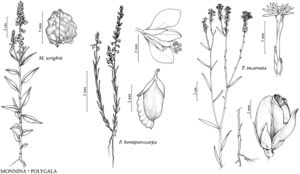Polygala hemipterocarpa
Smithsonian Contr. Knowl. 5(6): 31. 1853.
Herbs perennial, single or multistemmed, 1.2–4 (–5.6) [–7.5] dm, unbranched or branched distally; from thickened caudex. Stems erect, sometimes slightly glaucous, usually glabrous, rarely with few scattered, minute hairs, those appressed to incurved. Leaves alternate; sessile or subsessile; blade linear to linear-lanceolate, (3–) 6–25 × 0.6–1 mm, base obtuse, apex acute to subacuminate, surfaces glabrous. Racemes loosely cylindric, 3–15 (–21) × 0.4–0.8 cm; peduncle 0.5–2.5 cm; bracts deciduous, ovate to lanceolate-ovate. Pedicels 0.5–1 mm, usually glabrous, rarely puberulent. Flowers white, greenish veined, 3–4.5 mm; sepals ovate, 1.6–2.3 mm; wings obovate or elliptic-ovate, 3–4.3 × 1.6–1.8 mm, apex obtuse (rarely to bluntly rounded); keel 3.4 mm, crest 2-parted, with 3 lobes on each side, each 2–4-lobed. Capsules oblong, 4–6.3 × 2.3 mm, abaxial locule not winged, adaxial locule longer, winged, wing broadly scarious, erose-crenulate. Seeds 2.7 mm, pubescent, coat with rows of pits 0.05 mm wide; arils 2 mm, lobes 1/3–2/3 length of seed, vestigial, or to 1/3 length of seed in wingless abaxial locule.
Phenology: Flowering spring–fall.
Habitat: Rocky slopes in grasslands, open woodlands.
Elevation: 1400–2600 m.
Distribution
Ariz., N.Mex., Tex., Mexico (Chihuahua), Mexico (Durango), Mexico (eastern Sonora), Mexico (Tamaulipas)
Discussion
Polygala hemipterocarpa is known only from the Chihuahuan and eastern Sonoran deserts.
Selected References
None.
